Choosing the quietest power generator is dependent on numerous factors. Arguably the most important is your needs, as this influences power level and, by extension, noise output.
Once you have a clear idea of the 3 main factors, selecting the best quiet generator isn’t too difficult. However, getting to this stage is what takes the most work.
So, that’s what I cover in this article. Below, you’ll find all the information you need to make an objective decision on the best quiet generators on the market for use at home, in your RV, or while camping.
How Noise is Measured in Generators
Unsurprisingly, we use decibels to measure sound coming from generators. Manufacturers will almost always include a decibel measurement in their generators’ specifications. Even so, there are a few things worth knowing before you rush to buy the quietest generator you can find.
Measurement Distance
Noise outputs are most often measured at a distance of 23 feet (7 meters) from the generator. This is because you won’t usually be standing next to a generator while it’s operating. Instead, it might be located in an outbuilding or away from your RV.
Unfortunately, there’s no clear reason why 23 feet and not more. It does seem to relate to the ISO 7344 and the array of microphones that should circle the generator at regular intervals.
For a fair comparison between different models, you should ensure the noise in specifications is measured at the same distance (and in the same condition, like in an anechoic chamber). Manufacturers should state the distance at which the noise measurements were taken. If not, it’s fair to assume it’s 23 feet, although it’s not a guarantee. By extension, if you keep your generator closer to your home or RV, expect it to be louder.
Measurement Tool
To measure noise output, manufacturers will use a sound meter. However, a more accurate tool would be a loudness meter. Its measurements correlate more effectively to the ear’s perceived loudness.
What we use to measure noise output from a quiet generator isn’t super important. It’s worth noting, though, that if you were to buy your own sound meter for use at home, you’ll probably get different readings.
Environmental Factors
You’ll get different readings at home due to environmental factors. Noise output studies will be heavily controlled in quiet environments for a more ‘realistic’ measurement of a generator’s sound levels.
But when you set one up in your backyard or next to your RV, you’ll have other things to contend with. For example, the noise of a nearby road will be 40-45dB, which will impact the accuracy of your noise measurement.
Rather than conducting your own sound measurements, simply refer to this chart of the decibel levels of common sounds. It’ll be far more helpful in determining whether a generator is ‘loud’ or not.
| Common Sound | Noise Level (dB) |
| Whispering | 10 |
| Quiet Office | 50 |
| Normal Conversation | 60 |
| Heavy Traffic | 80 |
| Chainsaw | 100 |
| Fireworks | 150 |
How Many dB is a Quiet Generator?
Although the exact decibel output will vary by generator, it’s possible to give some rough values based on power level. Here’s a list of the typical ranges of common wattages.
- 3000 W: 45-60dB
- 4000 W: 50-60dB
- 5000 W: 65-70dB
- 7000 W: 55-75dB
- 10000 W: 75-80dB
These are pretty generic noise output levels, however. As you can see, there’s quite a bit of crossover between running watts because there are other factors involved in picking quiet generators.
Generator Load
Most manufacturers will give their generators’ noise outputs at varying load levels. Typically, these will be 25% and 50% load. These figures mean the generator is running at a quarter or half of its full capacity. For example, a 10000W generator running at 25% and 50% load would be 2500W and 5000W, respectively.
The reason for this is simply because the numbers are lower, so they look better. Also, it’s working under the assumption that you won’t be running the generator at full load, which ultimately depends on your needs.
As I’ve explained numerous times in my posts on AC units, it can actually be helpful to buy a more powerful appliance. For example, if you need 4000W of generator power, consider buying a 7000W model. Its noise output at 50% load (3500W) will be a more accurate representation of the noise level you could expect when compared to a 4000W generator running at full load. After all, you might not even have a dB rating for this. However, the difference for generators is that this extra power comes at the expense of portability.
Power-to-Noise Ratio
There is a simple tradeoff between power levels and noise output when looking at generators. Because they typically run off gas-powered engines, more powerful generators will have larger engines and, by extension, higher noise outputs.
However, there are secondary factors that can influence noise levels. Additional casing and inverter generators are perhaps the most obvious. I’ll go into more detail below regarding how these impact noise levels.
Calculating the Ratio
To understand this relationship more clearly, let’s look at some calculations for the power/noise ratio. The basic formula is running wattage divided by decibel rating. However, because we typically don’t have dB ratings for a generator’s full load, we can instead look at the ratio for 25% load, which is the lowest level of load rated.

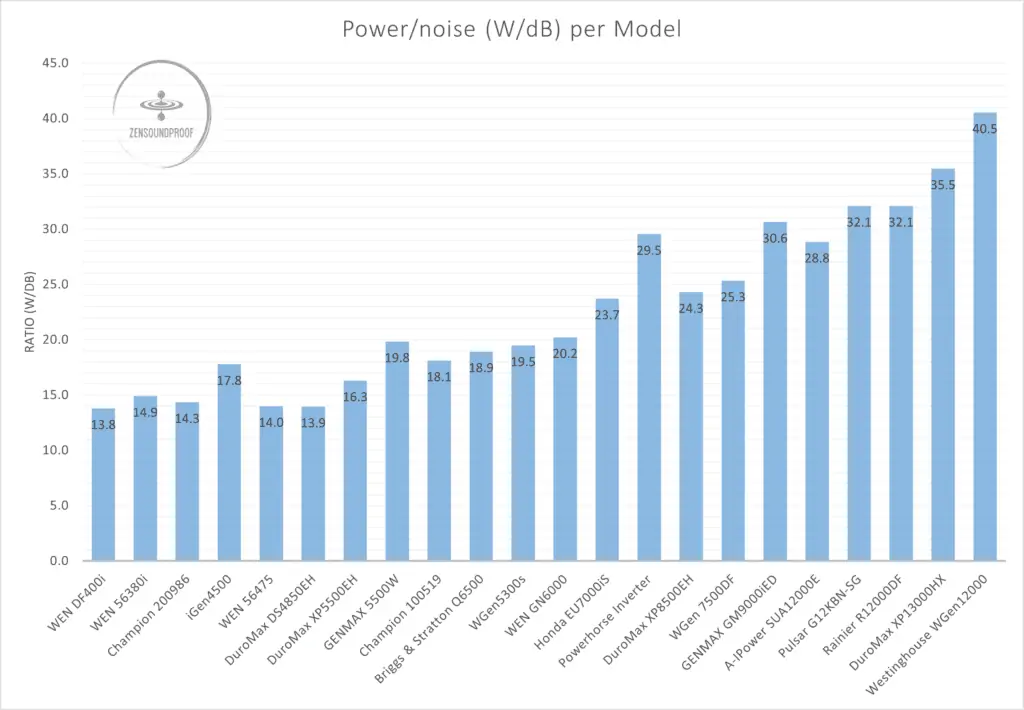
I’ve established the ratio for all the models I’ve reviewed so far. A clear trend appears out of the relation between the ratio and running power. Some rough figures are as follows:
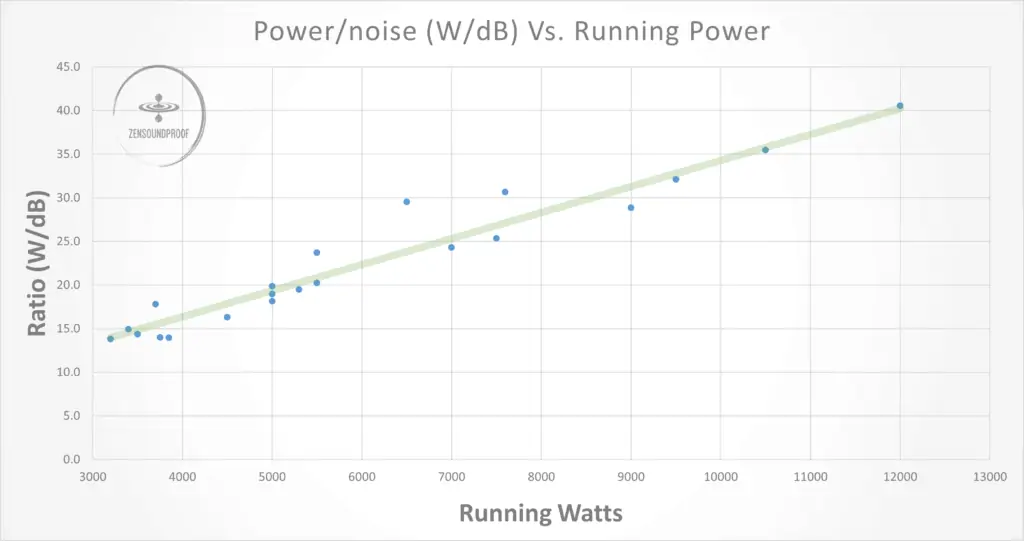
As you can see, there is a correlation between overall generator size and its power/noise ratio. This is primarily because power is a linear scale (4000W is twice as powerful as 2000W), whereas decibels are logarithmic. When we increase the generator size, then, we don’t see a directly proportional increase in sound emissions.
| Generator Size (W) | Average Power/Noise Ratio |
|---|---|
| 3000 | 13.5 |
| 4000 | 16.5 |
| 5000 | 19.5 |
| 7000 | 25.5 |
| 10000 | 34.5 |
When buying a generator in a certain power range, you’ll want to have the highest ratio possible within that range. For example, if you hesitate between 3 models at 5000 running watts, the one with the highest ratio will be the quietest. As such, I wouldn’t recommend a model with a ratio below 19.5; anything above 19.5 would be a better choice.
It’s not necessary to go into much more depth than this. The bottom line is that the ratio is a useful comparison tool to assess a generator’s noise efficiency in relation to its power.
Narrowing Your Choices
Wattage is the primary factor when it comes to choosing a quiet generator. After all, you’ll want a generator that can power everything you need, whether this is for camping or at home during a power outage.
Either way, your first stop should be deciding the total running wattage you need. From there, you can then begin to narrow down your selections based on other factors, such as noise output.
To get you started, here’s a series of articles I’ve written on quiet generators of different power levels:
- Quietest 4000W generator
- Quietest 5000W generator
- Quietest 7000W generator
- Quietest 10000W generator
However, if you need to filter by usage scenario, say, the best option for camping or for home, continue reading here.
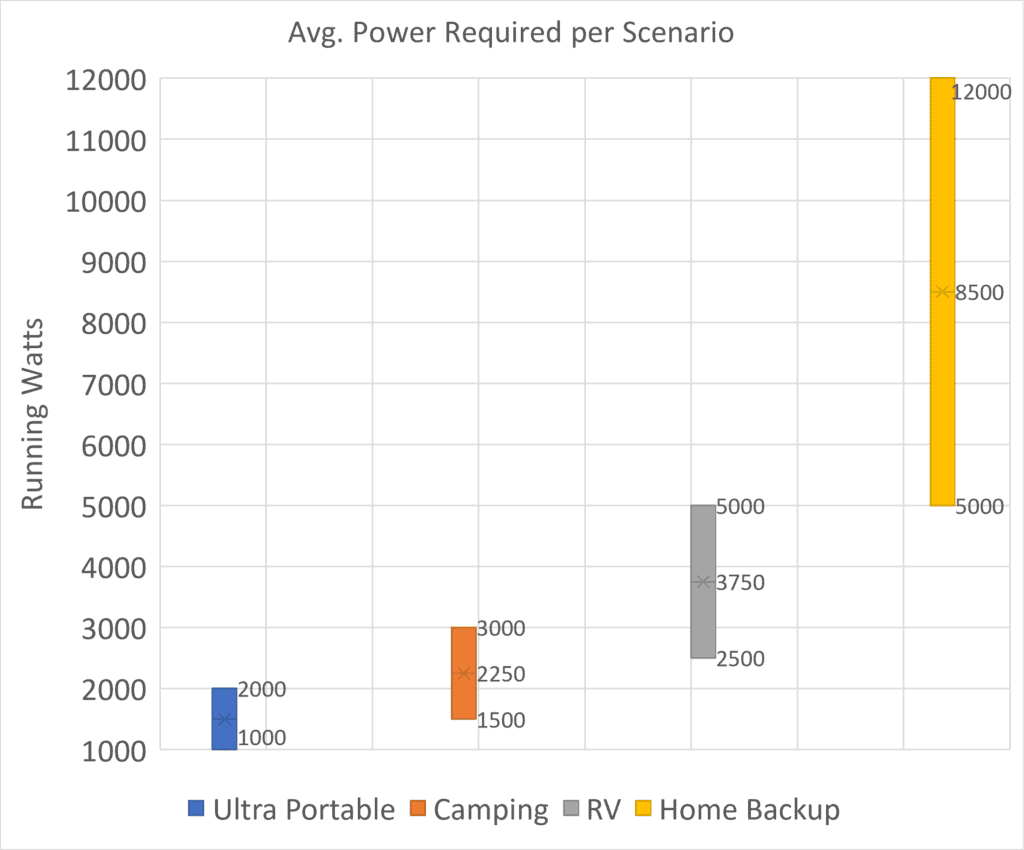
The chart above illustrates the power range needed for different functions: portable, camping, RV or home backup generator. Note that the portable category is for generators that would be carryable by one person with relative ease.
So, if you can’t decide on the best generator for your needs by dB rating alone, we’ve prepared a top picks list by function.
Our Top 6 Generator By Function
Unlike the reviews linked above, this best-of list focuses primarily on function. Hopefully, it’ll be an easier way for you to pick the most suitable quiet generator for your needs. There’s arguably a bit of crossover between functions (such as camping or for an RV), but I’ve tried to keep them as distinct as possible.
1. Quietest Portable Generator: WEN 56203i Quiet Portable Generator
- Noise level: 51 dB min
- Starting Power: 2000 W
- Running Power: 1700 W
- Inverter: Yes
- Start: Electric & Recoil
- Dual fuel: No
- Run time: 7 hours (50% load)
- Tank capacity: 1 gal
- Outlet / Port:
2 x 120V 5-20R [15A] – (Household type)
1 x 12V Post
1 x 5V
- Wheels: No
- Handle: Yes
- Weight: 39 lbs.
For portable generators, you don’t need loads of power. Instead, finding the right ratio of noise output to weight is probably more important. Luckily, at only 39lbs. and 51dB, the WEN 56203i fits the bill.
It has a surge wattage of 2000 and a running wattage of 1700. This should be more than enough for uses such as cookouts and tailgate parties, where you’re most likely only powering lights and possibly a refrigerator. Importantly, its weight is roughly the equivalent of a large water dispenser, meaning it’s fairly easy to carry.
Despite its smaller size, you still get a decent array of outlets. There are 2 x 120V outlets and 12V and 5V DC outlets. Thanks to it being an inverter generator, it has low harmonic distortion (less than 1.2%). This means you won’t have any problems charging phones and other sensitive electronics.
The 1-gallon fuel tank can provide up to 7 hours of runtime at half load, which is good fuel efficiency for its size. There’s also an eco-mode to maximize fuel usage and the ability to connect 2 units in parallel. Doing so would give you a running wattage of 3400 for a bit of extra power when needed.
Its only real downside (as noted by some users) is that it can vibrate quite a lot when under load. This is likely due to it being a lightweight generator combined with its lack of wheels. Although this shouldn’t be an issue if you put it on grass, you might want to consider putting it on a foam mat on harder surfaces to reduce the vibrations.
- Good fuel efficiency.
- Weight is acceptable for a portable generator.
- Ability to run 2 units in parallel is useful.
- Can vibrate quite a bit.
2. Quietest Generator for Camping:
Westinghouse iGen2500 Portable Inverter Generator
- Noise level: 52 dB min
- Starting Power: 2500 W
- Running Power: 2000 W
- Inverter: Yes
- Start: Recoil
- Dual fuel: No
- Run time: 12 hours (50% load)
- Tank capacity: 1 gal
- Outlet / Port:
2 x 120V 5-20R [15A] – (Household type)
1 x 5V
- Wheels: No
- Handle: Yes
- Weight: 46 lbs.
The Westinghouse iGen2500 comes in at 46lbs. with a running wattage of 2200. Its starting watts is 2500, so it’s got a good extra kick of power compared to the WEN above. Sure, it is 7lbs. heavier, but this isn’t a considerable difference. It means you shouldn’t have too much difficulty getting it from your car to the campsite.
Its minimum noise output is 52dB, which is almost identical to the WEN. Similarly, low noise output is important when camping because you won’t have much between you and the generator to reduce its perceived loudness (a tent will do nothing, after all).
This generator has you covered for almost all the outlets you might need. There are 2 x 120V outlets and 2 x 5V USB outlets. Again, it’s an inverter generator, meaning harmonic distortion is less than 3%, so you’ll be fine to plug your phone in for charging. Although a 12V outlet would be useful when camping, not having one isn’t the end of the world.
You’ll get up to 12 hours of runtime at half load from the 1-gallon gas tank. The generator has an LED screen for monitoring gas levels, and there’s also an eco-mode for maximum fuel efficiency.
My only major critique is that it only features a recoil starter. While these are pretty reliable, they’re a lot more effort to use than an electric starter. If this’ll be a problem, consider the GENMAX GM3200i instead. It has an electric starter but operates at a minimum noise level of 62dB.
- Carry handle makes it easy to move around.
- Good power/noise ratio.
- Low harmonic distortion.
- Doesn’t have an electric starter.
3. Quietest Premium Generator for RV:
Honda EU3000i
- Noise level: 50dB
- Starting Power: 3000 W
- Running Power: 2800 W
- Inverter: Yes
- Start: Electric & Recoil
- Dual fuel: No
- Run time: 19 hours (25% load)
- Tank capacity: 3.4 gal
- Outlet / Port:
2 x 120V 5-20R [20A] – (Household type)
1 x 120V L5-30R [30A]
- Wheels: No
- Handle: Yes (Not extendable)
- Weight: 130.7 lbs.
The Honda EU3000i is one of the best for an all-round quiet RV generator. Its noise output is 50-58dB based on quarter and max load. The starting wattage is 3000 and its running wattage is 2800.
As such, it’d be ideal for running pretty much any appliance in your RV. 2800 watts should be fine for powering an RV AC unit, a refrigerator, and more. Note, however, that its weight of 130lbs. means it’ll be a bit challenging to carry on and off your RV. This is only made more challenging by the fact that it doesn’t have wheels.
Impressively, its 3.4-gallon tank can run for up to 19 hours at 25% load. Even at full load, it offers a generous 7 hours of runtime. It comes with an electric starter, which is quick and easy to use.
In terms of outlets, it’s not loaded, but has the standard amount for a generator of this size. You get 2 x 120V 20A and a 120V 30A. Plus, if the standard power output isn’t enough, you can wire 2 up in parallel for a maximum of 6000 watts. However, there is no DC output (USB or automotive) which is a bit of downside for a small generator.
The biggest drawback of the Honda is that it’s expensive. However, you’re paying for a premium product with one of the quietest noise levels on the market. Combined with the impressive runtime, it (almost) justifies the price.
- Impressive 19 hours of runtime.
- Quiet operation.
- Enough power output for parties, backyards, etc.
- Expensive.
- No DC output (i.e., automotive or USB).
- No wheels.
4. Quietest Budget Generator for RV:
WEN 56380i
- Noise level: 57 dB min
- Starting Power: 3800 W
- Running Power: 3400 W
- Inverter: Yes
- Start: Electric & Recoil
- Dual fuel: No
- Run time: 8.5 hours (50% load)
- Tank capacity: 2.2 gal
- Outlet / port:
2 x 120V 5-20R [15A] – (Household type)
1 x 120V TT-30R [30A] – (RV type)
1 x DC 12V
1 x USB
- Wheels: Yes
- Handle: Yes (Foldable)
- Weight: 99 lbs.
The WEN 56380i is my top budget pick for camping for several reasons. It’s less costly while being more powerful than the Honda (3800W and 3400W), and is also much lighter (99lbs.). The extra bit of power should help when camping, as you can charge devices, power lights, and more without worrying about overloading it.
Also, it’s an inverter generator with a casing, which is typically quieter than conventional generators. It operates at 57dB at quarter load, which is about the level of standard conversation. Providing you keep it 23 feet from your tent, it shouldn’t be too noticeable.
Another reason why it’s great for camping is the range of outlets. There are 2 x 120V 15A, a 120V 30A, a 12V and a 5V USB. Like the Honda, it’s an inverter and thus has low harmonic distortion (less than 1.2%). As a result, you can plug your sensitive electronics directly into the generator without any concerns.
Its 8.5-gallon fuel tank offers up to 8.5 hours of runtime at half load. Although this isn’t as efficient as the Honda, it’s still enough for you to be able to go to sleep without it running out. If that does happen, though, it has a fuel shutoff function to maximize its runtime. There’s also an eco-mode, which moderates the engine’s RPMs for greater efficiency.
There’s very little bad to say about this generator. My only complaint is that the wheels are quite small compared to its size. As stated by some users, this makes it very difficult to move across grass and uneven surfaces. However, at 99lbs., it’s light enough for 2 people to carry it with relative ease.
- Good range of outlets for use when camping.
- Low harmonic distortion.
- Eco-mode and fuel shutoff for maximum efficiency.
- Wheels could be bigger.
5. The Quietest Home Generator:
GENMAX GM9000iED
- Noise level: 62 dB min
- Starting Power: 9000/8550 W (gas/propane)
- Running Power: 7600/7200 W (gas/propane)
- Inverter: Yes
- Start: Electric & Recoil
- Dual fuel: Yes
- Run time:
On gasoline, 10 hours (50% load)
On propane, NC - Tank capacity: 6.9 gal
- Outlet / port:
4 x 120V 5-20R [20A] – (Household type)
1 x 120/240V L14-50R [50A]
1 x 120/240V L14-30R [30A]
2 x USB
- Wheels: Yes
- Handle: Yes (Foldable)
- Weight: 280 lbs.
Now we’re starting to get into the categories where power and functionality override noise output. As such, I’ve picked the GENMAX GM9000iED as my selection for the best home backup generator.
Its noise output at quarter load is 62dB, so it’s not substantially louder than the WEN model above. However, with a surge wattage of 9000 and a running wattage of 7600, it’s got plenty of kick for powering your home appliances.
Better yet, its range of outlets means you can run appliances such as a refrigerator and an AC unit. You get 4 x 120V, 2 x 120/240V with 30A and 50A fuses, and a 5V outlet. You can also run the 120V and 240V simultaneously, meaning you don’t have to prioritize your AC over other appliances.
The 6.9-gallon gas tank will give you a whopping 15 hours of runtime at 25% load or 10 hours of runtime at 50% load. It’s also a dual fuel generator, so it can run off propane. The generator features Low Idle mode for greater fuel efficiency, and a remote start key fob for easier functionality.
Its biggest downside, though, is its weight. At 280lbs., it’s pretty heavy. However, this isn’t a massive issue at home because you should only need to move it into its permanent location. The wheels and handle do make this job easier, though.
It’s worth noting that a running wattage of 7600 should be enough for smaller homes. But if you need a bit of extra kick, consider the Westinghouse WGen12000. The surge wattage is 15000 and its running wattage is 12000.
Importantly, it’s a very similar price to the GENMAX despite its extra power. Also, its runtime is 11 hours, although its gas tank is considerably bigger (10.5 gallons). However, this does come at a cost: its noise output is 74dB, which is noticeably louder.
- Very quiet for its power level.
- Plenty of outlets suitable for RVing.
- You can run 120V and 240V power simultaneously.
- Quite heavy.
6. Quietest Dual Fuel Generator:
Pulsar G12KBN-SG
- Noise level: 74 dB min
- Starting Power: 12,000 / 9,500 W (gas/propane)
- Running Power: 10,800 / 8,550 W (gas/propane)
- Inverter: No
- Start: Electric & Recoil
- Dual fuel: Yes
- Run time:
On gasoline, 12 hours (50% load)
On propane, not communicated - Tank capacity: 8 gal.
- Outlet / Port:
4 x 120V 5-20R [20A] – (Household type)
1 x 120/240V L14-30R [30A]
1 x 120/240V L14-50R [50A]
1 x 12V Post
- Wheels: Yes
- Handle: Yes (Foldable)
- Weight: 209 lbs.
Picking the quietest dual fuel generator is a bit of a challenge. Unlike the categories above, a dual fuel generator could be for any size or purpose. However, my pick is based on use at home, as that’s where you’re most likely to have a tank of propane. As such, the Pulsar G12KBN-SG is my top pick.
Its noise level is 74dB, the same as the Westinghouse. It’s slightly less powerful: its gas wattages are 12000 and 9500. On propane, you’ll get 10800 peak and 8550 running wattages. It’s standard for generators to be less powerful when running on propane.
The 8-gallon gas tank can provide up to 12 hours of runtime at 50% load. With a 20lb. propane tank, you can expect around 5 hours at the same load (consumption of 0.94 gallons-per-hour). As such, this is one of the more fuel-efficient generators in its power category.
You get 6 outlets on this generator. There are 4 x 120V 20A, and 2 x 120/240V outlets with 30A and 50A fuses. Finally, there’s a 12V DC outlet for charging batteries. It comes with a twist-lock L14-30R outlet, which you can hook up to your home’s breaker box. However, with a harmonic distortion rating of less than 10%, it’s on the higher end of ‘good’. In short, think twice before you plug your sensitive electronics into it.
There’s not much bad to say about this generator. Its biggest downside is the 1-year warranty. This is about the absolute minimum you’ll want, and means you might not run the generator at all before it expires.
- Decent fuel efficiency.
- Dual fuel is useful for home power backup.
- Plenty of outlets.
- Warranty could be longer.
Starting vs. Running Watts: How Much You Need
In the reviews above, I discuss starting and running watts. These are different measurements of a generator’s power output and are the most important factors when deciding which is right for your needs.
The definitions aren’t particularly complicated, but we’ll run through some examples for clarity.
Starting watts (also called surge watts or peak watts) are the maximum power output a generator can produce. Running watts are the standard power output it’ll produce during normal functioning, and is the value on which loads are calculated.
In short, starting watts are there to provide an extra short-term boost of power to start devices with internal motors. This includes things like AC units, refrigerators, water pumps, etc. A generator isn’t capable of producing this level of power constantly, though.
So, when calculating your desired wattage, you need to know the running watts of all devices you plan to power, along with the surge watts of anything that contains a motor. You can check out this list for a pretty comprehensive rundown of standard appliances.
You can always check the label on the back of your appliance. It normally displays the voltage and current. Multiply both to get the power consumption.
P (Watts) = Tension (Volt) x Current (Amp)
Once you’ve listed all your devices, you then need to add up all the running watts with the highest starting watt value. An example looks like this:
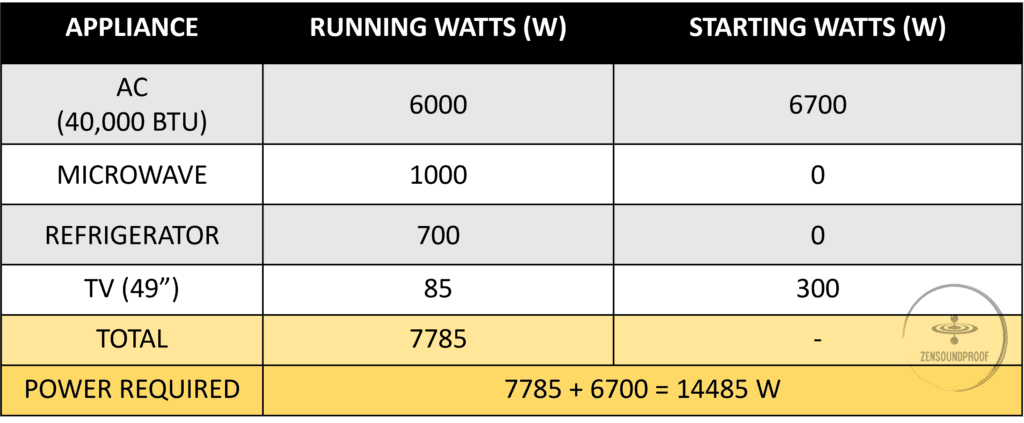
In this example, our total is 14,485 watts. So, to run all these devices comfortably at the same time, you’d want a generator with at least 15000 starting watts. As you can see, powering home appliances will either require a powerful generator or careful management.
What Else Matters before Buying
I’ve focused primarily on noise output as my main review factor. However, as I’ve mentioned, you should balance this against functionality because there’s little point in choosing the quietest generator if it doesn’t meet your needs.
Here’s what else you should consider when picking the best quiet generator.
Runtime
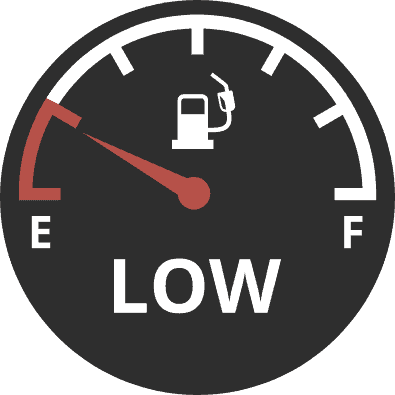
Runtime is a calculation of how long a generator can run on a full tank of gas. Tank size is an important factor, but so is fuel efficiency. Typically, manufacturer values will be given at either 25% or 50% load and full load.
Runtime stats are more important than a smaller fuel tank capacity. Look at fuel efficiency specs more than anything, as the tank size is only relative to the amount of fuel you’ll need on standby.
There’s not much to be said about runtime other than that low fuel consumption means filling up the tank less. For generators that you plan to take camping or keep at home, it’ll be worth choosing one with a minimum of 8 hours runtime. Doing so will hopefully mean you can sleep through the night without refilling it or losing power!
Inverter Generators
An inverter generator is one that controls the engine’s RPM to produce power at a stable frequency and current. Conventional generators can only run on full throttle all the time, which can result in harmonic distortion.
In short, total harmonic distortion (THD) is a measurement of variations in voltage frequency and intensity. It’s not super important to go into much detail about what this means more generally, other than that you should look for the lowest THD value possible.
THD can prevent sensitive electronic devices, such as phones, tablets, and laptops from recognizing the power signal. As such, it’s best to avoid plugging these into a conventional generator, because their THD levels are typically higher than on inverter generators.
Lower THD values translate to cleaner power. A THD of 5% or lower is considered a clean signal. This will be most important when you’re camping or RVing, as you’re more likely to need to charge your devices directly from the generator.
If you’re interested in how an inverter works to modulate a power signal, check out the video below:
Electric Start
Most modern generators have an electric starter in the form of a button. Much like on a car, this is a battery-powered ignition that starts the main engine. However, all generators will have a manual starter in the form of a recoil cord. This is essentially the same starting mechanism as a chainsaw or lawnmower.
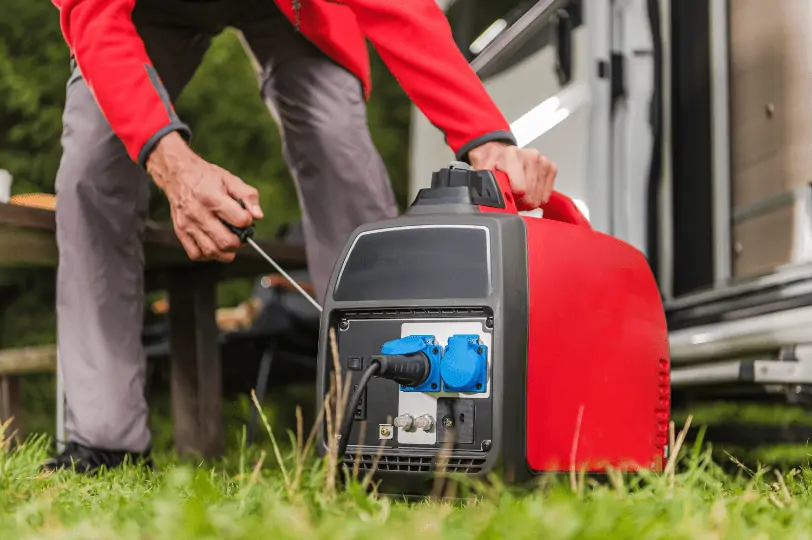
Electric starters are little more than a convenience. That said, they’re usually more reliable and save plenty of manual labor pulling on the recoil cord! Nowadays, the vast majority of generators come with that feature.
Outlets

The type and quantity of outlets on a generator will depend on your needs. For example, if you’re tailgating, a simple pair of 120V outlets will probably be enough. However, if it’s for use at home or a jobsite, you’ll probably want a greater range.
You’ll want a minimum of 120V, 20A or 120V, 30A outlets (5-20R or L5-30R respectively). Pretty much all standard household appliances run on these. But 240V outlets, such as L14-30R or L14-50R (rated with either 30A or 50A fuses) are for more power-hungry devices, such as AC units and water pumps. Obviously, these won’t be as important for something like camping.
Make sure you keep an eye on the outlet’s amperage. This is a measurement of power drawn, and if you exceed the value, the fuse will blow. All devices will state their voltage and amperage somewhere, so check everything matches up to the outlets.
Some generators will also feature direct current (DC) outlets in the form of USB ports or a 12V automotive plug. You’d need these for low-voltage devices, such as batteries, phones, tablets, etc.
Portability
Every generator on this list is technically portable in that it has wheels. However, there’s quite a difference between moving a 49lb. generator and a 350lb. one.
Ultimately, it’ll depend on your needs. For example, you’ll want a highly portable generator when going camping because it’ll likely go from your car to the campsite and home again. Luckily, your power demands will be less, so you can get away with lighter models.
On the other hand, an at-home generator for power outages probably won’t need moving much, if at all. You can get away with a significantly more powerful generator because it can live in a fixed location.
Extra Features
The features listed below aren’t necessarily requirements, but they can make working the generator much easier:
- CO sensor. Shuts the engine down if it detects high levels of carbon monoxide in the air (may be a requirement in some states).
- Low oil shutoff. This stops the generator before any damage is caused due to low oil.
- Fuel shutoff. Basically the same thing but for fuel.
- Digital fuel gauge. Allows you to monitor fuel consumption accurately.
- Remote starter. A key fob so you can start the generator from a distance.
- Weatherproof outlet covers.
- Dual fuel. This means the generator can run on gasoline or propane, giving you greater flexibility.
How to Quiet a Noisy Generator
The main source of noise in a generator is its engine. As with all other engines, they produce sound and heat as waste products when converting gas or propane into electrical energy.
Despite the generators above being of fairly decent noise levels, there are numerous options for making a generator quieter. My top tips are:
1. Add a muffler. Unsurprisingly, a muffler reduces the noise pollution coming from the generator’s exhaust. You can buy or make a generator muffler without too much difficulty.
2. Build a baffle box. This is a more in-depth project. In short, it involves building a soundproof box for storing your generator. The box combats airborne noise coming from the engine and can be pretty effective.
You can find instructions for how to build one – along with plenty of other tips – in my full article on how to make a generator quiet.
To Wrap Up
I hope this article has helped you narrow down your choices for the best generator. Your pick should primarily be based on your watt requirements, which are influenced by your intended function.
Usually, I circle back to my overall top pick here, but this is an article summarizing the best of the best. As such, each generator on this list is a great balance of power, functionality, and noise output for its category.
Do you have any other tips for picking a top-tier quiet generator? I’d love to hear your thoughts below.






